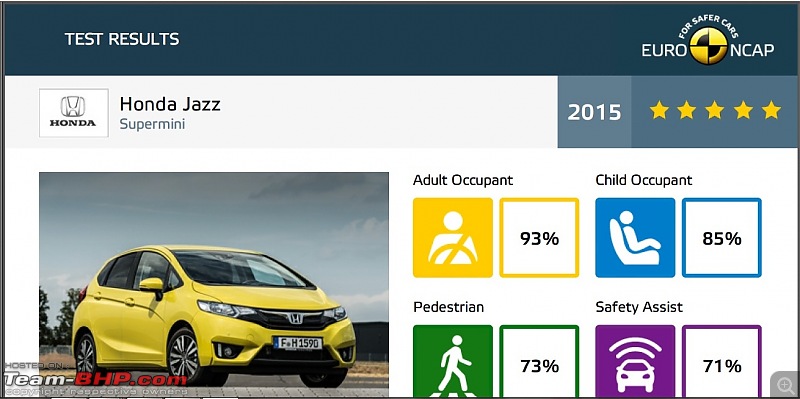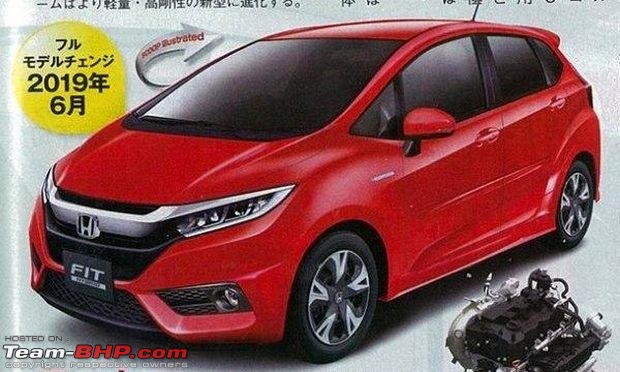| Re: 2015 UK-spec Honda Jazz gets 5 Stars in Euro NCAP Crash Test
It becomes a matter of simplistic generalisation, if we look at structural integrity, when we take into consideration just the weight of the car sold in the Indian and the UK markets.
The chassis or frame is the most important safety aspect of a modern vehicle, aside from the internal components such as the engine and transmission. As well as being a point for all components to attach to, the frame is essential during a crash, when the car is at risk of collapsing from pressure due to either rolling or having a weight pressing from above.
Throughout automotive development over the past century, the focus on safety has led to seat belts, crumple zones and airbags. Some of these developments were found in cars as early as the 1960s, only becoming standard over the past two decades.
But despite these advancements, a strong structural vehicle frame remains just as important as ever. Most vehicles from larger manufacturers over the past few years have prioritised strong frames, especially to protect passengers during accidents.
Frames have evolved substantially in the time vehicles have been on the road, shifting from a simple assembly underneath the vehicle on the earliest cars, to highly complex structures in modern vehicles. Structural frames now commonly absorb massive impacts from all directions – including the ceiling.
High-strength low-alloy steel (HSLA) which is used extensively in cars sold in developed (UK, EU, US) markets is a type of alloy steel that provides better mechanical properties or greater resistance to corrosion than carbon steel. HSLA steels vary from other steels in that they are not made to meet a specific chemical composition but rather to specific mechanical properties.
It is this mechanical property that plays a major role in the crash test ratings along with the SRS Supplemental restraint systems (Airbags, Seatbelts), and the Electronic Stability control, ABS & EBD) which put together gives the ratings.
HSLA have a carbon content between 0.05–0.25% to retain formability and weld ability. Other alloying elements include up to 2.0% manganese and small quantities of copper, nickel, niobium, nitrogen, vanadium, chromium, molybdenum, titanium, calcium,rare earth elements, or zirconium.
Why do we need to know about these metals used in very small quantities?
Copper, titanium, vanadium, and niobium are added for strengthening purposes.These elements are intended to alter the microstructure of carbon steels, which is usually a ferrite-pearlite aggregate, to produce a very fine dispersion of alloy carbides in an almost pure ferrite matrix.
This eliminates the toughness-reducing effect of a pearlitic volume fraction yet maintains and increases the material's strength by refining the grain size, which in the case of ferrite increases yield strength by 50% for every halving of the mean grain diameter.
Copper, silicon, nickel, chromium, and phosphorus are added to increase corrosion resistance. Zirconium, calcium, and rare earth elements are added for sulfide-inclusion shape control which increases formability. These are needed because most HSLA steels have directionally sensitive properties. Formability and impact strength can vary significantly when tested longitudinally and transversely to the grain. Bends that are parallel to the longitudinal grain are more likely to crack around the outer edge because it experiences tensile loads. These very greatly enhance the direction of force transmission, in case of impacts; away from the occupants of the vehicle.
They are used in cars and other structures that are designed to handle large amounts of stress or need a good strength-to-weight ratio. HSLA steel cross-sections and structures are usually 20 to 30% lighter than a carbon steel with the same strength.
Because of their higher strength and toughness HSLA steels usually require 25 to 30% more power to form, as compared to carbon steels.
The point here is that High strength steel is 20 to 30 percent lighter and in a thousand kilo car that means that if we use high strength steel the car will weigh 700 – 800 kilos. Hence, it is just not the matter of some missing features.
It is this high strength steel that gives the structural integrity of the monocoque (vehicle structure in which the chassis is integral with the body), in modern cars and not the normal carbon steel which is used in the construction of cars here in our country.
Moreover, even if high strength steel was used it might not be to the extent to those cars sold in other developed markets as our existing legislature permits auto manufactures to build such contraptions, while being on the right side of the law.
There are still vehicles on the market that suffer from poor design, and thus should be avoided. But we do not get to do a comparo on how they are built and designed. I for one have always wanted to make a compare of the various models on these lines. Anybody game for this? This will be a landmark study which will change the way cars are built for INDIA.
To quote an example: The Tesla Model S electric sedan is a good example of a car with a strong frame, and a safe car in general. The vehicle managed to capture a five-star rating both overall and in every sub-category in the American National Highway Traffic Safety Administration (NHTSA).
During the roof validation test, where the structural integrity of the top frame is judged, the testing machine failed at just above 4Gs. This means that at least four additional fully loaded Model S vehicles could be stacked above the vehicle without the roof caving in.
Tesla claims it achieved this by using aerospace-grade bolts for the centre pillar reinforcement.
Hence, the weight of the car nor the THUD of a door shut is a real indicator of good integrity. I for one will strongly suggest that the build process, the quality of steel used, the fabrication process (the expertise, the equipment used) etc, is more of a factor than the weight or the thud. The God is in the details as they say!
Happy Motoring! |  (2)
Thanks
(2)
Thanks
 (9)
Thanks
(9)
Thanks
 (1)
Thanks
(1)
Thanks
 (2)
Thanks
(2)
Thanks


 (1)
Thanks
(1)
Thanks








